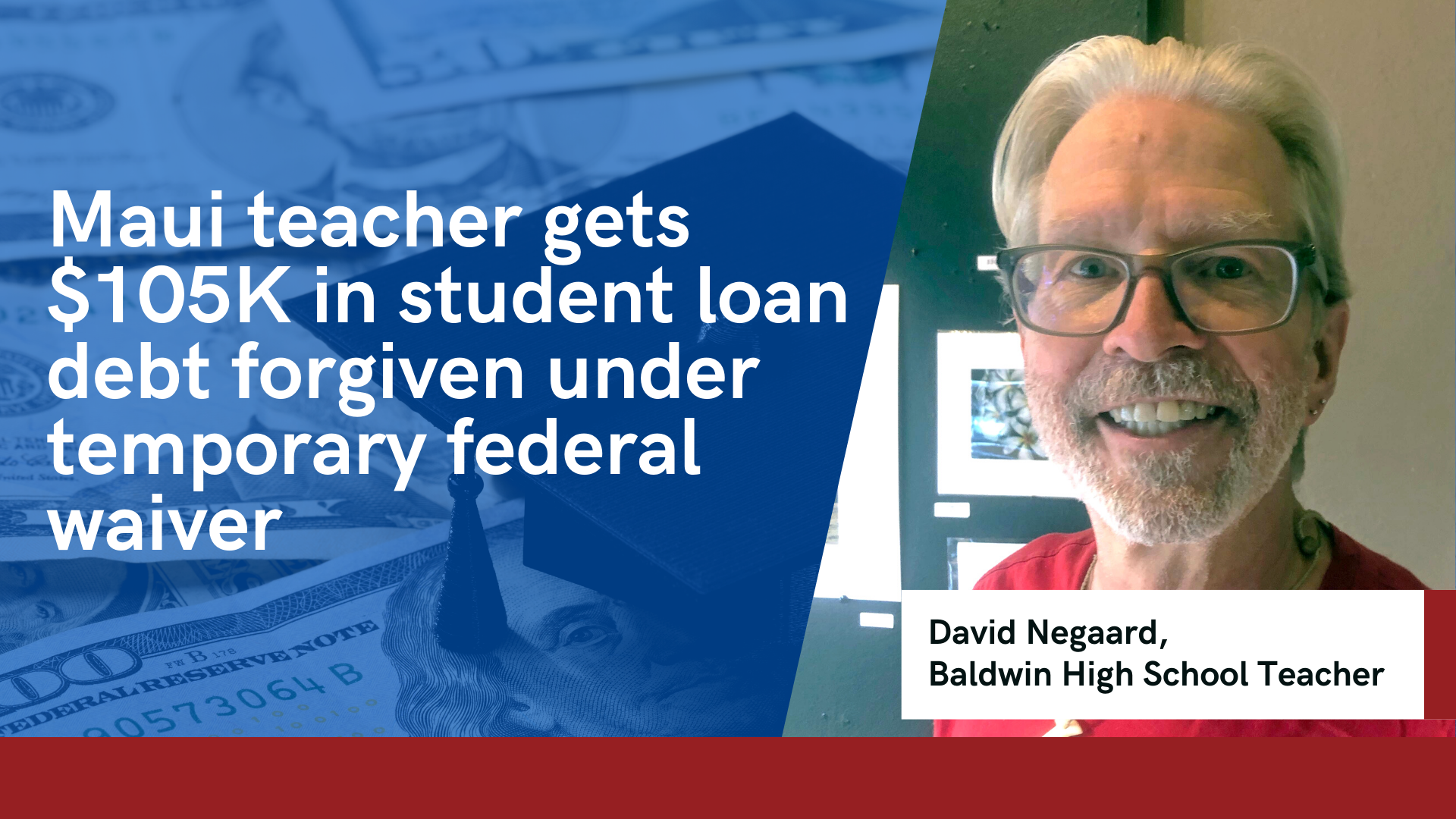Teachers must apply for loan forgiveness by October 31 of this year
Updated: January 26, 2022
Baldwin High School English teacher David Negaard, who had a total of $114,000 in student loan debt, recently had $105,000 of that debt forgiven, thanks to the U.S. Department of Education overhauling its long-dysfunctional Public Service Loan Forgiveness Program (PSLF).
He took out $75,000 in student loans about 30 years ago to pay for his bachelor’s degree from Graceland University in Iowa and a master’s degree from Central Washington University. After paying off $35,000, his debt ballooned to nearly double what he had borrowed from a combination of working as an educator and periods of deferments and forbearance.
“I moved to Hawaii knowing what the financial situation was going to be, and I don’t regret it, but I knew that it meant that I would not get to retire,” the 62-year-old Negaard said of his gargantuan loan balance.
Almost 10 years after calling Hawaii home, Negaard is starting to think retirement might be a possibility now that the government is working to make more borrowers eligible for debt forgiveness.
One of the biggest changes is a temporary PSLF waiver that allows all payments by student borrowers to count toward forgiveness, regardless of loan program or payment plan. It also waives restrictions on the type of repayment plan and the requirement that payments be made in the full amount and on-time.
Certain criteria for forgiveness have to be met, however, and borrowers will have to submit their applications for loan forgiveness by Oct. 31, 2022, meaning the process is not automatic. Of the requirements, 120 payments (do not need to be consecutive) have to be made, and one must work for a qualifying employer, like the Hawaii State Department of Education. Loans have to be direct or consolidated into a Direct Consolidated Loan.
Did you know? Suspended payments due to the COVID-19 emergency relief payment suspension count toward forgiveness for some borrowers under Income-Driven Repayment Plans, making it more likely for your balance to be forgiven.
“After going through the process, I got a letter one day that $22,000 just disappeared from my loan balance,” Negaard said. “I was fortunate enough to have five of my loans that I wasn’t expecting to be gone vanish because of the waiver.”
Negaard’s application yielded another $82,000 in forgiveness earlier this month, with only $9,000 of the original $114,000 remaining.
NEA makes loan forgiveness a reality for members
Before the overhaul, the forgiveness process was “terribly byzantine,” Negaard said. “It was needlessly complicated, and they denied many many more people than they actually approved,” with only 2% of applicants receiving forgiveness from November 2020 to April 2021.
Changes to the PSLF program, while desperately needed, didn’t happen overnight. Over the past few years, the National Education Association (NEA) led a coalition of 200 organizations urging the U.S. Department of Education to reform PSLF. The department received nearly 200,000 personalized messages from members on the issue.
There’s evidence the pressure tactic worked, too. The federal government has forgiven nearly $2.4 billion because of the waiver so far, with about 38,000 PSLF borrowers receiving forgiveness.
“With all the other things that demoralize teachers in our world right now, having a loan that you’re never going to get out of is just one more thing. And I really believe that things like this, if they are real, can help to stave off that existential despair that causes so many of my colleagues to bail,” Negaard said.
Take action now for forgiveness
While the temporary waiver makes thousands of more borrowers eligible for forgiveness, the biggest takeaway is that the process is not automatic and will not be offered indefinitely. The deadline to apply for the temporary waiver is Oct. 31, 2022.
Negaard broke down the steps he took toward getting his student loans forgiven:
- Start at studentaid.gov.
- Log In or Create an Account.
- Utilize the Help Tool to start the process. The Help Tool will ask you to enter your employer’s name and other personal information to determine if you qualify for forgiveness.
- Follow the prompts and steps the Help Tool recommends to determine your eligibility and start the process for loan forgiveness.
Negaard says he’s done a “bunch of reading” on the subject of forgiveness and found himself “stressed out and a little overwhelmed” at the complexity of it all. He found a Facebook page called Public Service Loan Forgiveness Program Support (PSLF) that’s proven extremely helpful, and even hopeful. Members of the page share stories of their forgiveness and exchange tips on the best way to navigate the system.

